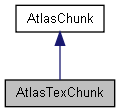|
|||||||||||||||||||||||||||||||||||||||||||||||||||||||||||||||||||||||||||||||||||||||||||||||||||||||||||||||||||||||||
Public Types | |
| typedef AtlasChunk | Parent |
| FormatJPEG | |
| Use (lossy) JPEG compression. | |
| FormatPNG | |
| Use (lossless) PNG compression. | |
| FormatDDS | |
| Use (fast-to-load, big, lossy) DDS with DXT compression. | |
| enum | TexFormat { FormatJPEG, FormatPNG, FormatDDS } |
Public Member Functions | |
| AtlasTexChunk () | |
| ~AtlasTexChunk () | |
| virtual void | read (Stream *s) |
| Deserialize from a stream. | |
| virtual void | write (Stream *s) |
| Serialize this chunk to a stream. | |
| virtual U32 | getHeadSentinel () |
| virtual U32 | getTailSentinel () |
| virtual void | process () |
| Once the chunk has been loaded (in another thread), this is called in the main thread to prepare any complex resources. | |
| void | generate (AtlasChunk *children[4]) |
| Given four children, (re)generate the data for this one. | |
| const bool | isBitmapTexFormat (const TexFormat f) const |
| AtlasTexChunk * | generateCopy (S32 reformat=-1) |
Static Public Member Functions | |
| static GBitmap * | loadDDSIntoGBitmap (const U8 *ddsBuffer, U32 ddsBufferSize) |
Public Attributes | |
| TexFormat | mFormat |
| U8 | layerCount |
| If we're storing opacity map data there may be more than one layer worth of image data. | |
| GBitmap * | bitmap |
| DDSFile * | dds |
Private Member Functions | |
| void | writeDDS (Stream *s) |
Member Typedef Documentation
| typedef AtlasChunk AtlasTexChunk::Parent |
Member Enumeration Documentation
Constructor & Destructor Documentation
| AtlasTexChunk::AtlasTexChunk | ( | ) |
| AtlasTexChunk::~AtlasTexChunk | ( | ) |
Member Function Documentation
Deserialize from a stream.
- See also:
- You probably want to use readFromStream()
Reimplemented from AtlasChunk.
Serialize this chunk to a stream.
- See also:
- You probably want to use prepareDeferredWrite()
Reimplemented from AtlasChunk.
| virtual U32 AtlasTexChunk::getHeadSentinel | ( | ) | [virtual] |
Reimplemented from AtlasChunk.
| virtual U32 AtlasTexChunk::getTailSentinel | ( | ) | [virtual] |
Reimplemented from AtlasChunk.
| virtual void AtlasTexChunk::process | ( | ) | [virtual] |
Once the chunk has been loaded (in another thread), this is called in the main thread to prepare any complex resources.
(For instance, a texture or VB, that depend on access to GFX to initialize.)
Reimplemented from AtlasChunk.
| void AtlasTexChunk::generate | ( | AtlasChunk * | children[4] | ) | [virtual] |
Given four children, (re)generate the data for this one.
Their order starts at topleft, clockwise, 0123.
Reimplemented from AtlasChunk.
| AtlasTexChunk* AtlasTexChunk::generateCopy | ( | S32 | reformat = -1 |
) |
| static GBitmap* AtlasTexChunk::loadDDSIntoGBitmap | ( | const U8 * | ddsBuffer, | |
| U32 | ddsBufferSize | |||
| ) | [static] |
Member Data Documentation
If we're storing opacity map data there may be more than one layer worth of image data.
(e.g. we have 10 channels of opacity data and PNG only supports 4 channels/image, so we'd have to have 3 layers).
TOC versions prior than 150 only support a layerCount of 1.
